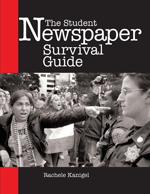As David Carr writes in The New York Times this morning, “It’s been an especially rotten few days for people who type on deadline."
Just consider:
- The Christian Science Monitor announced Tuesday it would cease publication of its weekday print edition.
- On the same day Time Inc., publisher of Time magazine, Fortune, People and Sports Illustrated, announced it was cutting 600 jobs and reorganizing its staff.
- Gannett, the largest newspaper publisher in the country, revealed plans to lay off 10 percent of its work force, as many as 3,000 people.
- On Monday, the Tribune Company announced it was cutting 75 more jobs from the newsroom of The Los Angeles Times, leaving it approximately half the size it was at the turn of this century.
- And The Star-Ledger of Newark, the 15th-largest paper in the country, declared plans to reduce its editorial staff by 40 percent.
All this came amid news that the nation's daily newspapers saw circulation decline more steeply than anticipated. On Monday the Audit Bureau of Circulations reported that average weekday circulation was 38,165,848 at 507 of the nation's leading dailies in the six months ending in September, a 4.6 percent decline from 40,022,356 a year earlier. Up till then, advertising revenue had risen quarter after quarter.
Here at the Marriott in downtown KC, where nearly 1,800 students and advisers involved in college media are gathered for five days of workshops and panel discussions, we urge students to develop new skills. We encourage them to "think multimedia," we teach them how to create interactive maps, audio slide shows and video reports for the Web so that they'll be able to do things that 25-year veteran reporters and photographers can't. We tell them they need to be flexible, creative and skilled in many areas to survive and thrive.
But even with such new media skills, where are they going to get jobs? News Web sites are struggling too. And online publications do not appear to be the savior of their print counterparts.
As Carr notes in his column, "More than 90 percent of the newspaper industry’s revenue still derives from the print product, a legacy technology that attracts fewer consumers and advertisers every single day."
Two weeks ago, the Times and other news media reported that online revenue at newspaper sites was stalling. In the second quarter, it was down 2.4 percent compared with last year, to $777 million, according to the Newspaper Association of America.
The impact here in Kansas City is palpable. Only three media companies sent recruiters to the convention, down from about 14 in previous years. Why should they meet with potential employees when they have no jobs to fill?
And still we talk here about the power of "capital-J" journalism. We encourage our students to seek out the truth, to expose wrongs, to, as the old saying goes, "comfort the afflicted and afflict the comfortable."
What will students here be thinking as they head home Saturday and Sunday after sitting through session after session and speech after speech? Will they mull over the words of inspiration and the heartfelt advice from media professionals and journalism educators? Will they pledge to develop new skills and embrace new media?
Or will they simply think about changing majors. Maybe philosophy isn't so impractical after all. At least opportunities for philosophers aren't evaporating before their eyes.




